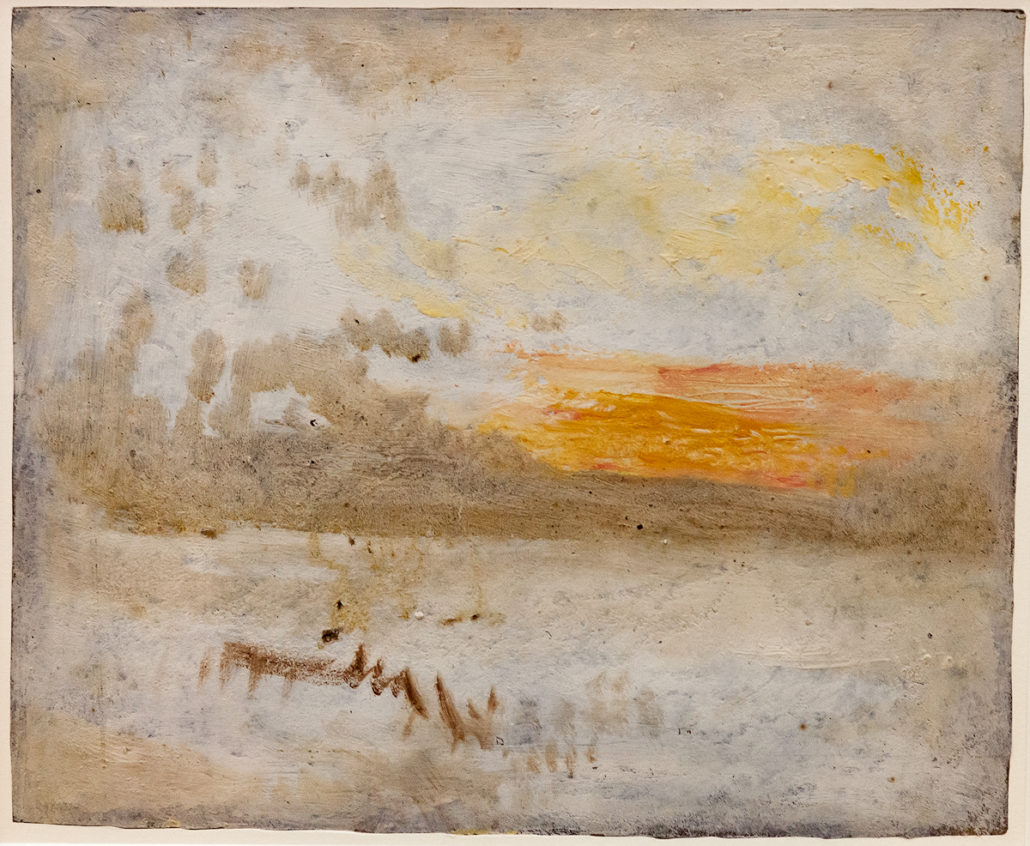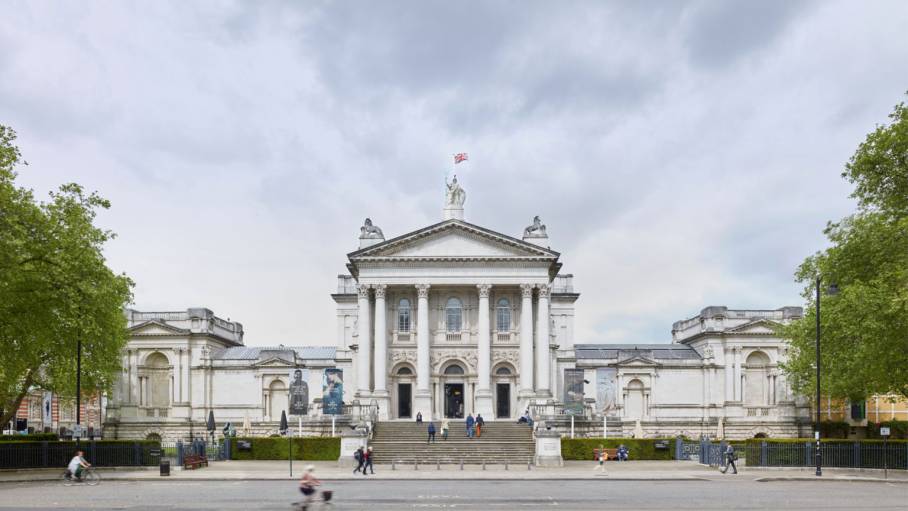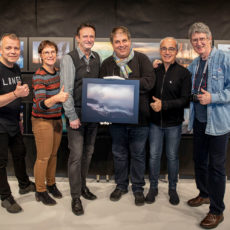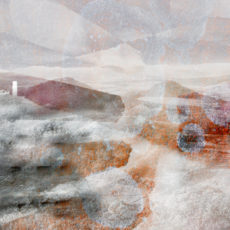Through the Imaginative Landscape of JMW Turner – Part 1., INTRO
 Wikipedia: Joseph Mallord William Turner was born in Maiden Lane, Covent Garden, London, in a flat over his father’s barber and wig shop. His mother suffered from depression after the death of her daughter in 1786. This might have been the reason why the then ten-year-old William was sent to his maternal uncle in Brentford, west of London. The earliest known artistic exercise by Turner is from this period. Turner entered the Royal Academy of Art in 1789, aged 14, for a probation period. Turner travelled widely in Europe collecting material for his paintings. Besides England and Scotland he would also cross the Channel to Europe travelling to Germany, Italy and France. As he got older, Turner became increasingly eccentric. He had few close friends except for his father, who lived with him for 30 years and worked as his studio assistant. Turner died in 1851 at the home of his friend Sophia Caroline Booth in Chelsea. Apparently, his last words were “The Sun is God”.
Wikipedia: Joseph Mallord William Turner was born in Maiden Lane, Covent Garden, London, in a flat over his father’s barber and wig shop. His mother suffered from depression after the death of her daughter in 1786. This might have been the reason why the then ten-year-old William was sent to his maternal uncle in Brentford, west of London. The earliest known artistic exercise by Turner is from this period. Turner entered the Royal Academy of Art in 1789, aged 14, for a probation period. Turner travelled widely in Europe collecting material for his paintings. Besides England and Scotland he would also cross the Channel to Europe travelling to Germany, Italy and France. As he got older, Turner became increasingly eccentric. He had few close friends except for his father, who lived with him for 30 years and worked as his studio assistant. Turner died in 1851 at the home of his friend Sophia Caroline Booth in Chelsea. Apparently, his last words were “The Sun is God”.
For me, Turner is the predecessor of the Impressionists. Besides oil painting, he was also renowned for his watercolours and I cannot stop being fascinated by his simple watercolour studies of the sun and the individual colour planes. For one period of time, I was haunted by not being able to approximate his paintings in the abstract areas of my photographs.
His early artistic course was influenced by Edmund Burke’s essays “Sublime and the Beautiful”.According to Burke, landscape painting ought to have focused on what is infinite, astonishing, heroic and on unconquerable nature that makes man stand in fear and  awe… Turner was one of the few painters who were respected and highly appreciated during their lifetime. He held his first exhibition at the age of 15 and from 17 years of age he was a regular participant of the Royal Academy exhibitions (similar to The Salon in Paris). Later, he became professor of perspective at the Academy. It is typical of him, that especially in his later works, he did not follow each and every rule but the sole effect of colour – it was not Cézanne but Turner to be the first to manipulate perspective for creative purposes. It was noted that he did not have talent for lecturing and often he would get mixed up in his theories and his listeners would very soon get confused.
awe… Turner was one of the few painters who were respected and highly appreciated during their lifetime. He held his first exhibition at the age of 15 and from 17 years of age he was a regular participant of the Royal Academy exhibitions (similar to The Salon in Paris). Later, he became professor of perspective at the Academy. It is typical of him, that especially in his later works, he did not follow each and every rule but the sole effect of colour – it was not Cézanne but Turner to be the first to manipulate perspective for creative purposes. It was noted that he did not have talent for lecturing and often he would get mixed up in his theories and his listeners would very soon get confused.
 In order to understand his work one needs to realize that he lived during the British Industrial revolution and while many of his works, especially from the earlier stage, might resemble the works of landscape artists of the turn of the 18th and 19th centuries, the subject matter diverged significantly from them – a fascination with machinery, ships, heavy industry, bridges… those would be hardly found in the works of older authors. The London Academy, where he worked, was not only a place of the fine arts. Turner would meet mathematicians, physicists, and he would transfer many of their observations (e.g. the observation of light and the solar corona) into his painting methods. The quote “The Sun is God” refers to his unique ability to capture the sun and the bright area surrounding it in an absolutely exceptional manner – how is it possible that one feels dazzled by the light in a painting??? In his compositions, he frequently placed the horizon in the lower third thus opening up the sky. His oils are always very dramatic – drama in the sky, drama on water, fires, avalanches, brewing storms… He often used smudged details, playing with an intentionally misty atmosphere. He balanced the division between light and darkness and organized the basic elements in a carefully calculated rhythm.
In order to understand his work one needs to realize that he lived during the British Industrial revolution and while many of his works, especially from the earlier stage, might resemble the works of landscape artists of the turn of the 18th and 19th centuries, the subject matter diverged significantly from them – a fascination with machinery, ships, heavy industry, bridges… those would be hardly found in the works of older authors. The London Academy, where he worked, was not only a place of the fine arts. Turner would meet mathematicians, physicists, and he would transfer many of their observations (e.g. the observation of light and the solar corona) into his painting methods. The quote “The Sun is God” refers to his unique ability to capture the sun and the bright area surrounding it in an absolutely exceptional manner – how is it possible that one feels dazzled by the light in a painting??? In his compositions, he frequently placed the horizon in the lower third thus opening up the sky. His oils are always very dramatic – drama in the sky, drama on water, fires, avalanches, brewing storms… He often used smudged details, playing with an intentionally misty atmosphere. He balanced the division between light and darkness and organized the basic elements in a carefully calculated rhythm.
“I don’t paint so that people will understand me, I paint to show what a particular scene looks like!”
 Thanks to intense travelling across England and Europe, Turner gradually abandoned the safe pictorial tradition and realistic painting. It was necessary to surpass what he himself, as professor, claimed. Brave attempts in his watercolour sketches and studies led him to quitting his teaching career. The new direction brought on by this change was not, however, a step of resignation of an expert on his own perfection; rather, it was encouraged by the completely new stimuli on his first encounter with Venice.
Thanks to intense travelling across England and Europe, Turner gradually abandoned the safe pictorial tradition and realistic painting. It was necessary to surpass what he himself, as professor, claimed. Brave attempts in his watercolour sketches and studies led him to quitting his teaching career. The new direction brought on by this change was not, however, a step of resignation of an expert on his own perfection; rather, it was encouraged by the completely new stimuli on his first encounter with Venice.
Other than Venice and the Swiss Alps, Turner was also influenced by the landscape of his native England – one of those regions was Lake District. That is where our second photo expedition after Lanzarote was headed in 2019.
LAKE DISTRICT
Lake District is one of the most photographed regions in Great Britain. Founded in 1951, it is the largest national park on the islands. It comprises of about sixty lakes situated in a picturesque hilly countryside. At the same time, it is close to the sea and so space, time and light can be easily combined and that really is worth having in England! The hills of Lake District are quite barren and at sunset one might feel as though in a biblical landscape. Near the lakes, you can’t stop snapping that array of reflections and images on the water surface; by the sea, rocks vanishing in the waves; over Keswick, you can dive deep into history at the Castlerigg stone circle.
 The goal of the second part of ART CONTEMPLATIONS is the same as in the first one with Manrique, to understand the author’s work, get to know it and with that knowledge attempt to interpret the visited landscape and the narratives concealed in it through modern photographic means. In the end, we will publish a photo e-book together and hopefully hold a joint exhibition. The first step will be taken next week when we visit TATE Britain Gallery in London. My next post will be dedicated to this visit.
The goal of the second part of ART CONTEMPLATIONS is the same as in the first one with Manrique, to understand the author’s work, get to know it and with that knowledge attempt to interpret the visited landscape and the narratives concealed in it through modern photographic means. In the end, we will publish a photo e-book together and hopefully hold a joint exhibition. The first step will be taken next week when we visit TATE Britain Gallery in London. My next post will be dedicated to this visit.
9.2.2020, Liberec


